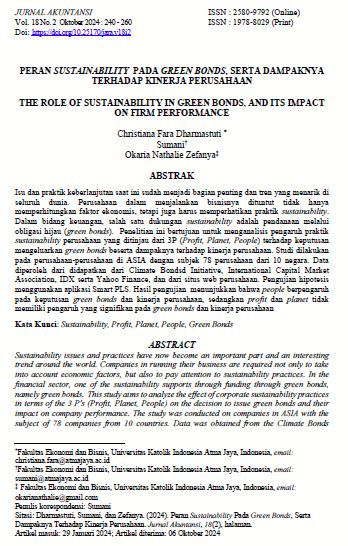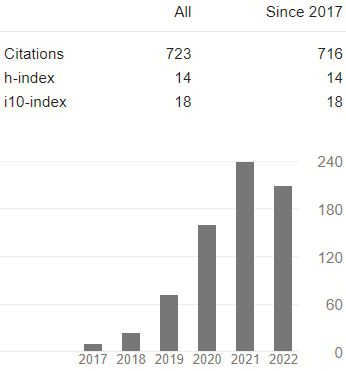THE ROLE OF SUSTAINABILITY IN GREEN BONDS, AND ITS IMPACT ON FIRM PERFORMANCE
DOI:
https://doi.org/10.25170/jak.v18i2.5178Keywords:
Sustainability, Profit, Planet, People, , Green BondsAbstract
Sustainability issues and practices have now become an important part and an interesting trend around the world. Companies in running their business are required not only to take into account economic factors, but also to pay attention to sustainability practices. In the financial sector, one of the sustainability supports through funding through green bonds, namely green bonds. This study aims to analyze the effect of corporate sustainability practices in terms of the 3 P's (Profit, Planet, People) on the decision to issue green bonds and their impact on company performance. The study was conducted on companies in ASIA with the subject of 78 companies from 10 countries. Data was obtained from the Climate Bonds Initiative, International Capital Market Association, IDX and Yahoo Finance and from the company's website. Hypothesis testing using the Smart PLS application. The test results show that people affect the decision of green bonds and company performance, while profit and planet have no significant effect on green bonds or company performance.
References
Agliardi, E., & Chechulin, V. (2020). Green bonds vs regular bonds: Debt level and corporate performance. Journal of Corporate Finance Research, 14(2), 83–99. https://doi.org/10.17323/j.jcfr.2073-0438.14.2.2020.83-99
Alexander, A., & Minnema, J. (2018). The relationship between leverage and profitability: A quantitative study of consulting firms in Sweden. Sweden: Umea School of Business, Economics and Statistics, 1–83.
Aouadi, A., & Marsat, S. (2018). Do ESG controversies matter for firm value? evidence from international data. Journal of Business Ethics, 151(4), 1027–1047. https://doi.org/10.1007/s10551-016-3213-8
Banga, J. (2019). The green bond market: A potential source of climate finance for developing countries. Journal of Sustainable Finance and Investment. https://doi.org/10.1080/20430795.2018.1498617
Carroll, A. B. (2004). Managing ethically with global stakeholders: A present and future challenge. Academy of Management Executive, 18(2), 114–120. https://doi.org/10.5465/AME.2004.13836269
De Lucia, C., Pazienza, P., & Bartlett, M. (2020). Does good esg lead to better financial performances by firms? Machine learning and logistic regression models of public enterprises in Europe. Sustainability 2020, 12(13), 5317. https://doi.org/10.3390/SU12135317
Denis, D. J., & Mihov, V. T. (2003). The choice among bank debt, non-bank private debt, and public debt: Evidence from new corporate borrowings. Journal of Financial Economics, 70(1), 3–28. https://doi.org/10.1016/S0304-405X(03)00140-5
Elkington, J. (2013). Enter the triple bottom line. In The Triple Bottom Line: Does it All Add Up. https://doi.org/10.4324/9781849773348
Fatica, S., & Panzica, R. (2021). Green bonds as a tool against climate change? Business Strategy and the Environment, 30(5), 2688–2701. https://doi.org/10.1002/BSE.2771
Fatihudin, D., Jusni, & Mochklas, M. (2018). How measuring financial performance. International Journal of Civil Engineering and Technology, 9(6), 553–557.
Flammer, C. (2021). Corporate green bonds. Journal of Financial Economics, 142(2), 499–516. https://doi.org/10.1016/J.JFINECO.2021.01.010
García-Amate, A., Ramírez-Orellana, A., Rojo-Ramírez, A. A., & Pilar Casado-Belmonte, M. (2010). Do ESG controversies moderate the relationship between CSR and corporate financial performance in oil and gas firms? https://doi.org/10.1057/s41599-023-02256-y
Gianfrate, G., & Peri, M. (2019). The green advantage: Exploring the convenience of issuing green bonds. Journal of Cleaner Production, 219, 127–135. https://doi.org/10.1016/J.JCLEPRO.2019.02.022
Hitchcock, D., & Willard, M. (2015). The business guide to sustainability: Practical strategies and tools for organizations. The Business Guide to Sustainability: Practical Strategies and Tools for Organizations, 1–290. https://doi.org/10.4324/9781315767390/BUSINESS-GUIDE-SUSTAINABILITY-MARSHA-WILLARD-DARCY-HITCHCOCK/ACCESSIBILITY-INFORMATION
Ji, L., Huang, J., Liu, Z., Zhu, H., & Cai, Z. (2012). The effects of employee training on the relationship between environmental attitude and firms’ performance in sustainable development. International Journal of Human Resource Management, 23(14), 2995–3008. https://doi.org/10.1080/09585192.2011.637072
Lebelle, M., Lajili Jarjir, S., & Sassi, S. (2020). Corporate green bond issuances: An international evidence. Journal of Risk and Financial Management. https://doi.org/10.3390/jrfm13020025
Lee, S., & Jung, H. (n.d.). The effects of corporate social responsibility on profitability The moderating roles of differentiation and outside investment. https://doi.org/10.1108/MD-07-2015-0268
Liu, Z., Li, J., Zhu, H., Cai, Z., & Wang, L. (2014). Chinese firms’ sustainable development-The role of future orientation, environmental commitment, and employee training. Asia Pacific Journal of Management, 31(1), 195–213. https://doi.org/10.1007/s10490-012-9291-y
Lungguran, U. K., & Sumani. (2022). Pengaruh implementasi sustainability (profit, people, planet) terhadap kinerja keuangan perusahaan dalam indeks Sri-Kehati. Jurnal Akuntansi, 16(1), 88–120. https://doi.org/pengaruh implementasi sustainability (profit, people, planet) terhadap kinerja keuangan perusahaan dalam indeks sri-kehati
Maltais, A., & Nykvist, B. (2021). Understanding the role of green bonds in advancing sustainability. Journal of Sustainable Finance and Investment, 11(3), 233–252. https://doi.org/10.1080/20430795.2020.1724864
Mizen, P., Tsoukalas, J. D., & Tsoukas, S. (2011). How does reputation influence a firm’s decision to issue corporate bonds? New evidence from initial and seasoned public debt offerings. SSRN Electronic Journal, January 2021. https://doi.org/10.2139/ssrn.1108532
Nguyen, P. A., Nguyen, A. H., Ngo, T. P., & Nguyen, P. V. (2019). The relationship between productivity and firm’s performance: Evidence from listed firms in Vietnam stock exchange. Journal of Asian Finance, Economics and Business, 6(3), 131–140. https://doi.org/10.13106/JAFEB.2019.VOL6.NO3.131
Nirino, N., Santoro, G., Miglietta, N., & Quaglia, R. (2021). Corporate controversies and company’s financial performance: Exploring the moderating role of ESG practices. Technological Forecasting and Social Change, 162. https://doi.org/10.1016/j.techfore.2020.120341
PwC. (2020). ESG oversight : The corporate director ’ s guide. November, 1–18. https://www.pwc.com/us/en/services/governance-insights-center/esg-guidebook-layout-final.pdf
Salas-Zapata, W. A., & Ortiz-Muñoz, S. M. (2019). Analysis of meanings of the concept of sustainability. Sustainable Development. https://doi.org/10.1002/sd.1885
Schoenmaker, D., & Schramade, W. (2018). Principles of sustainable finance. https://papers.ssrn.com/abstract=3282699
Subramaniam, Y., & Loganathan, N. (n.d.). Does green finance affect renewable energy development in Singapore? https://doi.org/10.1108/JABES-02-2023-0052
Tang, D. Y., & Zhang, Y. (2020). Do shareholders benefit from green bonds? Journal of Corporate Finance, 61. https://doi.org/10.1016/J.JCORPFIN.2018.12.001
Ulin Vardar, G., & Aydo, B. (n.d.). Investigating the ecological footprint and green finance: Evidence from emerging economies. https://doi.org/10.1108/JEAS-05-2023-0124
Zhou, X., & Cui, Y. (2019). Green bonds, corporate performance, and corporate social responsibility. Sustainability, 11(23). https://doi.org/10.3390/su11236881
Zumente, I., & Bistrova, J. (2021). ESG Importance for long-term shareholder value creation: literature vs. practice. Journal of Open Innovation: Technology, Market, and Complexity 2021, 7(2), 127. https://doi.org/10.3390/JOITMC7020127
https://www.epa.gov/climate-change
Climate Bonds Initiative. Explaining green bonds. https://www.climatebonds.net/market/explaining-green-bonds
Climate Bonds Initiative. (2019). ASEAN green finance state of the market. https://www.climatebonds.net/files/reports/cbi_asean_sotm_2019_final.pdf

Downloads
Published
Issue
Section
License
Copyright (c) 2024 Christiana Fara Dharmastuti, sumani sumani, Okaria Nathalie Zefanya

This work is licensed under a Creative Commons Attribution-ShareAlike 4.0 International License.
Authors who publish with this journal agree to the following terms:
- Authors retain copyright and grant the journal right of first publication with the work simultaneously licensed under a Creative Commons Attribution-ShareAlike 4.0 International License that allows others to share the work with an acknowledgment of the work's authorship and initial publication in this journal.
- Authors are able to enter into separate, additional contractual arrangements for the non-exclusive distribution of the journal's published version of the work (e.g., post it to an institutional repository or publish it in a book), with an acknowledgment of its initial publication in this journal.
- Authors are permitted and encouraged to post their work online (e.g., in institutional repositories or on their website) prior to and during the submission process, as it can lead to productive exchanges, as well as earlier and greater citation of published work.














